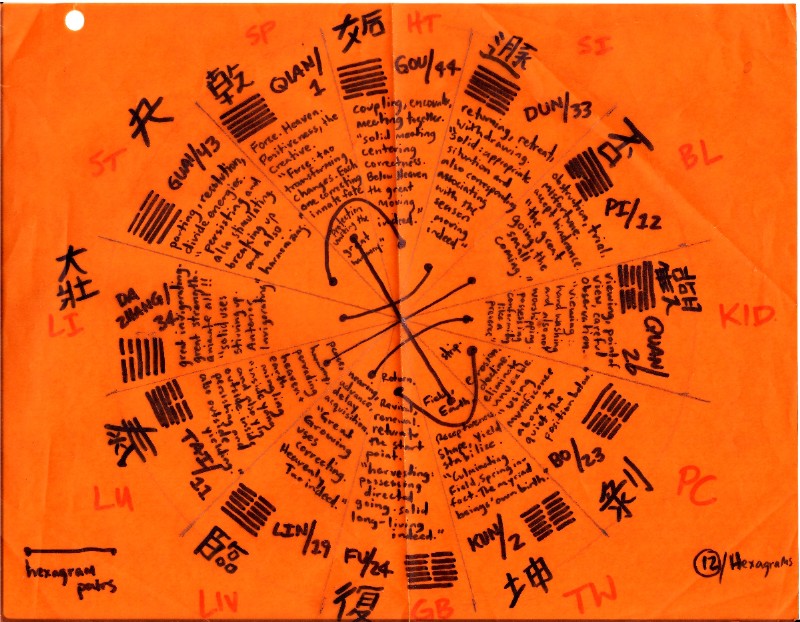I’d like to piggyback off of the organ clock post and introduce the Chinese medicine theory of organs in a little more depth.
Why should we pay attention to an alternative way of looking at the body – hasn’t conventional biomedicine (aka Western medicine) figured it all out? There are many ways of categorizing the various structures and functions of the body, some older, some newer. Each system takes different features of the human being to be primary, each system has used their own conceptual understanding to render a viable picture of the body and its interactions. Perhaps most importantly, each system uses their vision of the human being to craft effective treatments. It seems reasonable to expect that different systems will create different spheres of effectiveness – a topic for a future post.
1. There are twelve organ systems in Chinese medicine
Heart, Small Intestine, Bladder, Kidney, Pericardium, Triple Burner, Gall Bladder, Liver, Lung, Large Intestine, Stomach and Spleen. The typical convention is to capitalize when we are talking about Chinese organ systems and not to capitalize when we are referring to the anatomical organ known to Western medicine. Another convention is to refer to the in the singular. So, for instance, the Lung organ system includes the Lungs, but we don’t say – for example – The emotion of the Lungs is grief. Of course, these are just guidelines I’ve picked up from my time at NUNM. I’ve noticed at conferences or when talking to other students from other schools, they observe different conventions.
2. The physical, material organ isn’t necessarily the most important part.
Probably the most important thing to understand is that the classical Chinese view doesn’t stop at gross anatomy. Although the ancient Chinese did investigate the inside of the body and were clearly aware of the physical structures that Western medicine now names “organs” this is not primary for the medicine’s understanding. The organ is included in a larger concept that is often called the “organ system,” which you have already seen me use many times. This organ system includes the physical organ, it’s associated channel(s), the tissues, surfaces, functions and other bodily features associated with that organ and other more rarefied aspects of the system.
3. The organ systems work together as a dynamic whole.
While each system has specific functions and can be talked about in isolation, the beauty of the Chinese medical view of the body only becomes truly apparent when you focus on the interconnections. No system is complete without seeing its relationship to the rest. This can make it a little confusing to study because our brains seem to find it simpler to focus on one mono-dimensional thing at a time.
4. The organ systems are a reflection of the macrocosm.
This principle relates back to Chinese philosophical understanding of the holographic nature of reality. For a complete review of the holographic worldview, see Michael Talbot’s The Holographic Universe. The basic gist of this philosophy is that the fundamental nature of reality is reflected in its smallest pieces just as much as in its largest. The small reflect the large, and the large reflect the small – they’re both reflecting something much deeper than themselves. In Chinese medicine we study this principle all the time.
On one level, each organ is a reflection of all the others – the parts reflect the whole. On another level, the total complex of organs and each organ individually reflect some aspect of nature. For example, the Heart reflects the nature of our Sun and acts as such within the body. Understanding these layers of meaning help us to fully comprehend the human body, and studying the human body through this lens helps us to gain a greater understanding about the Universe.
5. Following from that, then, the organ systems can be understood using various types of symbols.
Learning about the Chinese concept of the body was much easier once I learned to think about it as an ecosystem or as a country. With the former, I could simply walk in nature in a mindful way and reflect on the various features I found there. IS the Heart like the Sun? What would that mean if it were? How does that bear out in diagnosis? In treatment?
I think this practice does its work on more subtle levels as well – it must be why we are constantly urged to spend time in nature as CCM students. Using metaphors about the government helped me a great deal in understanding the functional relationships between organ systems. If the Heart is like the Emperor (or Empress) then what relationships should I see between it and the Lung, which is said to be like the Prime Minister?
6. The organs’ interrelationships are therapeutically useful.
Far from being a simple intellectual exercise, understanding the organ systems as networks of interrelationship bears out in treatment. Take the example of a problem that you determine is centered around some dysfunction of the Heart organ system, say palpitations. Thinking too simplistically, you might focus on the Heart channel, or maybe the paired Small Intestine channel. You would find points on those and other channels that are known to impact the Heart. Perhaps you would prescribe some herbs associated with the Heart organ system.
This simplified approach would miss out on the therapeutic benefit of considering the interrelationships of organ systems. Instead – quickly review a few of the most well known organ system relationships to increase nuance. Is fire failing to be generated by wood? Being reversely controlled by metal? Perhaps thinking about the six conformations could have us considering how Kidney water might influence the Heart and create palpitations. Through leveraging this more nuanced reasoning, we’ll find many more treatment approaches – and most of the more effective than the simplified reasoning would engender.
7. Even with this complex understanding – the organ systems are not PRIMARY.
In a sense, the organ systems are simply a useful way of organizing the overwhelming amount of information we can get from studying the human body. It is a convenient way because it has clear physical correlates. But we must also consider the fluids of the body (Qi, Blood, Jing, Shen, JinYe) as well as any more subtle aspects of the human being. We must also keep in mind that the body is not just a jumble of parts, but a integral functioning whole – when we treat we are not “tonifying the Kidney” but instead having a specific kind of impact on an infinitely complicated system using a particular technique. Maybe that’s splitting hairs, but it seems an important distinction.
There’s a lot more to know – but that’s a good start. Please put any questions or thoughts in the comments!
[This post has been updated during the 2020 site updates. My goal during post updates was to keep the character of the original post, but update for corrections and clarity, as well as to remove broken links.]


[…] If you want to learn more about organ systems, please see my recent post on the subject – “7 Keys to understand the Chinese Medicine concept of organ systems.” […]